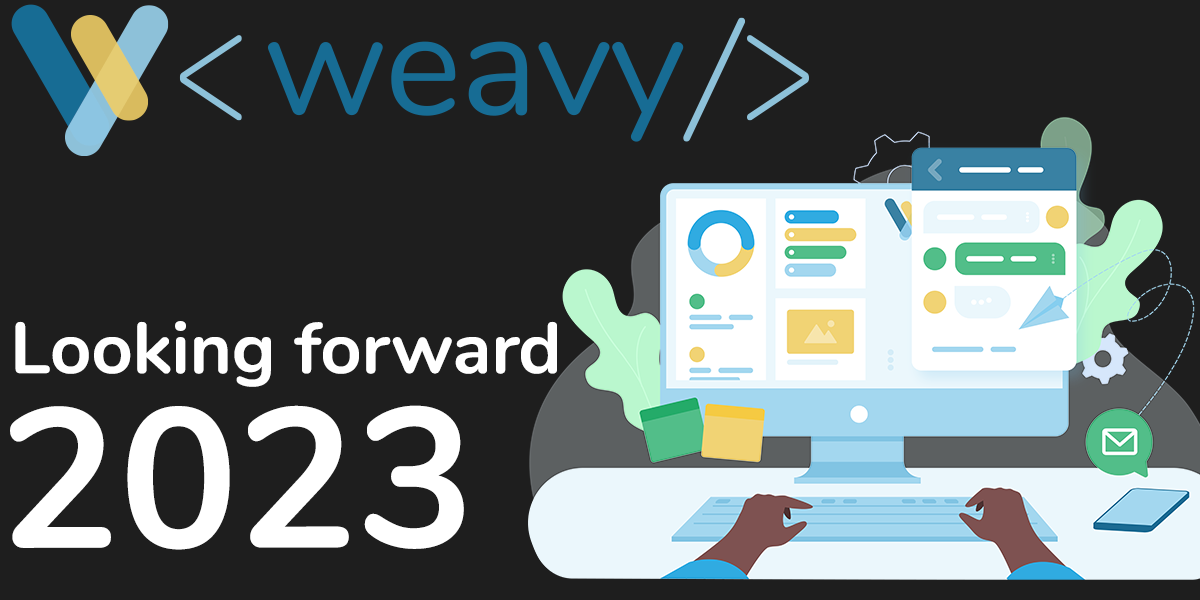Last week the team at Weavy took some time to reflect on our biggest milestones of 2022. Of course, despite my best efforts, we were not the only people in tech making waves. So before marching headlong into 2023, let’s take a look at some of the trends and developments of 2022, and make some perhaps foolhardy predictions for the year ahead.

Collaboration comes to the metaverse, kind of
In October 2021, Facebook CEO Mark Zuckerberg made the bold announcement that Facebook was to be renamed Meta. The reason for this multi–billion dollar facelift was that the company would be going all in on creating and maintaining the metaverse: a communal virtual space where people from all over the world could connect and communicate using virtual reality or mixed reality headsets. Meta announced that though the metaverse will eventually come to consume our lives, their first foray would be targeting professional users in partnership with Microsoft, details of which would be hammered out later.

Well in 2022 later finally came and Meta released a flagship $1500 mixed reality headset that would allow our corporate titans and start-up stars to meet in a virtual world where they could use Powerpoint and do Zoom calls, but now with a headset allowing them to see the dead eyed avatars of their colleagues. Understandably the reviews for this new reality were mixed.
Putting aside the high cost and incredibly underbaked software, early adopters of our new virtual collaboration paradigm discovered that using desktop apps like Microsoft Office and Zoom in a virtual environment is actually pretty difficult! The metaverse has come to the world of productivity with fairly little fanfare, but it is here, and only time will tell if it has legs.
SaaS gets social
While the biggest name in social media was trying to get productive, the players in productivity were getting social. At this years Collision Conference I had the opportunity to speak to hundreds of developers from teams of every size, in those conversations I quickly found that whether or not they knew it, they had some form of social features on their product roadmap:
“The developer of an app that connected car owners with automotive service providers played with our Feeds for a few moments before saying “you know, I’ve been trying to figure out an easy way for vendors to share updates with their customers.” A designer of a legal document collaboration app realized that our Files features would solve their problems with version history and securely sharing edits.”
Now that the SaaS productivity sector that exploded in 2020 has matured, most if not all of the developers in that sector have turned their eyes to retention. Community features like forums, chat, and feeds are incredibly effective at making users come back.
Years ago Salesforce made a big bet that community features were the future when it purchased Slack for a sum so large I still remember it over two years later. This $27 billion shot across the bow incentivized competitors to develop their own social features. According to CommunityLed, in that same period of time the number of companies with community teams increased by 22%, with the community teams often reporting directly to senior leadership. Clearly, fostering and maintaining community is a priority, even as the industry is tightening its belt.
What comes next: 2023
The past year has been incredibly difficult. The downstream consequences of supply chain issues, international aggression, and energy shortages have driven up the cost of pretty much everything. Fears of an impending recession have caused many companies to reevaluate their roadmaps. For this reason it’s especially difficult to make predictions for the coming year.
However, one thing that can be certain is that everyone at every organization is now more cost conscious than they have been since the 2008 financial crisis. Marching orders are inevitably going to be to do more with less. To achieve this, many app developers will be looking for ways to outsource features that traditionally would have been developed in house, and the easiest ways to do that are with APIs and low-code development tools.
In the last few years, apps utilizing commercial APIs like Weavy have gone up by over 60%, and I believe that the adoption rate will only accelerate in 2023. Between commercial APIs and other low-code tools, we may see a rise in so-called API first applications: apps where the majority of front and back end functionality is achieved through APIs and other low or no code building blocks.
To that end there may also be a rise in companies that, like Weavy, deal exclusively in APIs. In an economy where there’s more talent than opportunities, we’ll no doubt see a rise in entrepreneurship in the same way we did in the wake of the great recession. I, for one, welcome the influx of competition, and am excited to see what innovations emerge in this shifting economic landscape.